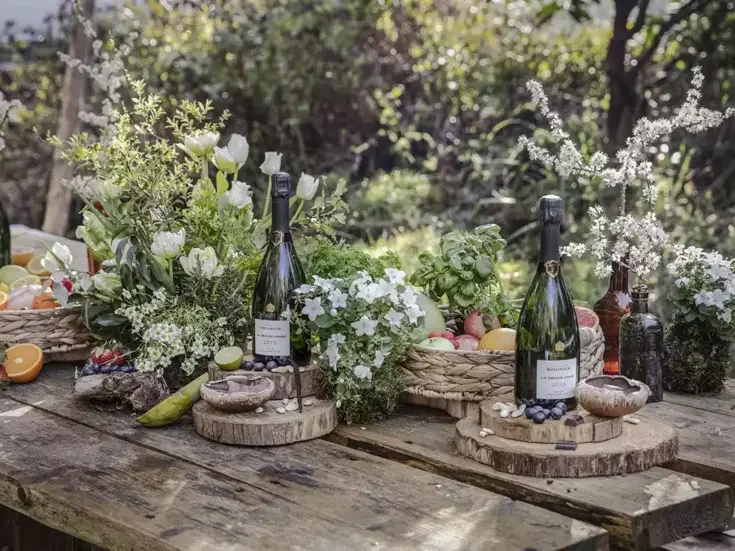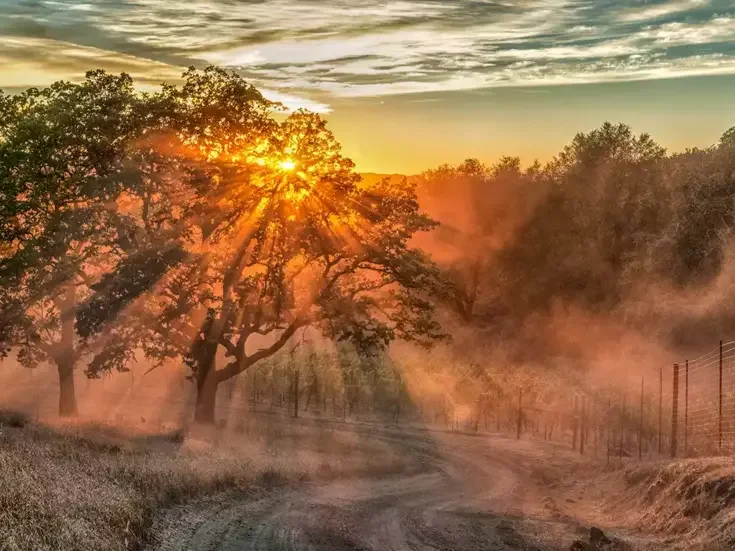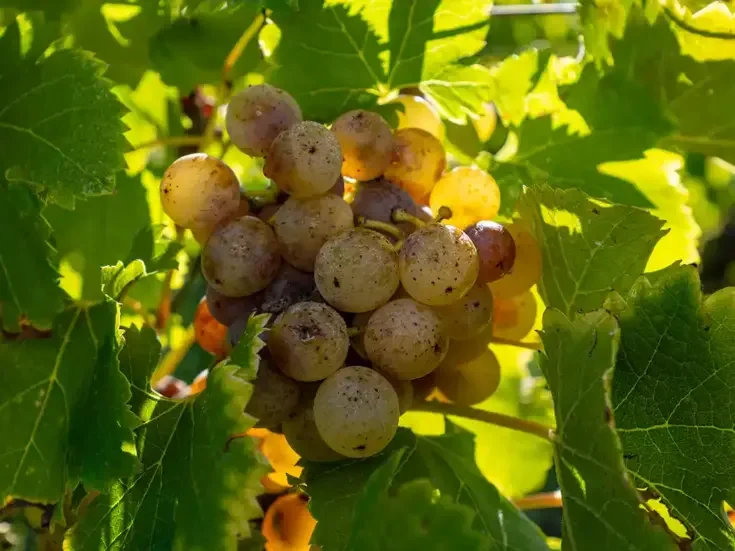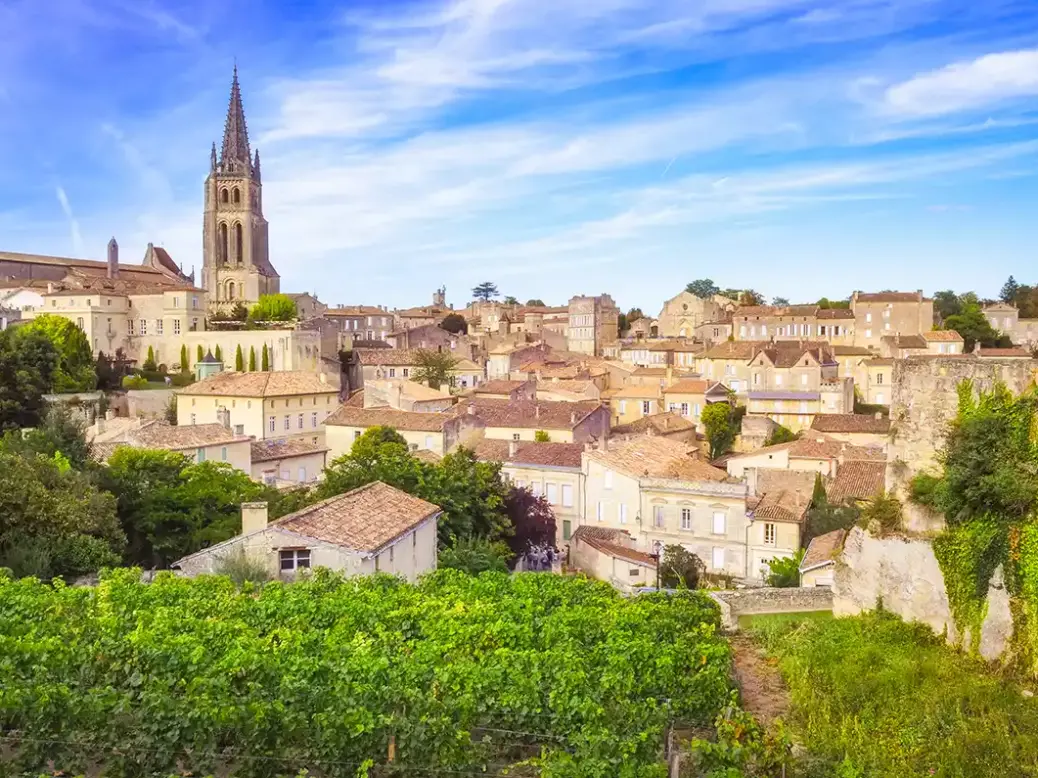
2023 Bordeaux tasting notes: Left Bank Part I
2023 Bordeaux tasting notes: Left Bank Part II
ST-EMILION
Château Ausone (60% CF, 40% M)
SF | The 11th generation of the Vauthier family to be dedicated to wine now guards these 7ha (17 acres) of hillside vines, their heritage unchallenged in the village. The same may be, to a greater or lesser extent, said of the wines, their tilt toward Cabernet Franc as persuasive now as it must have been a millennium ago. A rich color, then a striking nose of raspberry coulis, black cherry, and woodsmoke from beyond the kitchen garden. The aromatics are both pure and intense, timeless and yet thoroughly modern. The 20 months in new wood cannot be entirely neglected, and there are indeed hints of mocha and vanillin behind the fruit. Nothing overworked, however. The result is very refined, very fine, the tannic weave elegant and seemingly effortless, lightness conveyed through weight, intensity through delicacy. | 97–98
Chapelle d’Ausone (60% CF, 35% M, 5% CS)
SF | Younger vines they may be, but the terraces, the massal selection, and the superb clay-limestone terroir all play their part in a conspiracy of excellence. And yes, there is indeed a chapel amid it all. One thinks, only briefly, of Hermitage. The increasingly warm weather through August and into September guaranteed ripeness and allowed the youthful vines (some of them are not that youthful) full and eloquent expression. The wine’s aromatic personality is dominated by spice and flowers, carried elegantly across the palate. Powerful tannins—ripe but neither chalky nor astringent—underpin a stately and compelling edifice. Most impressive. | 94–95
Château Angélus (53% M, 46% CF, 1% PV)
SF | A rich purple color, imperious and firm. The nose is complex, energetic, and inviting: blue fruit, red fruit, black fruit—lots of fruit—then graphite, licorice, thyme, and iris. A hint of woodsmoke from the fields (one thinks of the peasants in Millet’s painting), honest labor, albeit tilted by artistry and the modernist impulses that underscore the Boüard family’s quest for (the new) authenticity. Inspiring winemaking, nonetheless, the quest for purity involving the use of 30hl foudres for aging part of the Cabernet Franc and a regime of low fermentation temperatures and cold soak, which almost makes one think of white-wine vinification. Purity is key here, after all, and it has been achieved beautifully. The intense style of 2023 seems to coincide nicely with the family’s aspiration to be both modern and traditional, aided no doubt by some fabulous old-vine Cabernet Franc. | 95–96
Carillon d’Angélus (90% M, 10% CF)
SF | Roses, red fruit, peonies, and slate—a charming nose, with similar appeal on the palate. Two opposing terroirs (geographically and stylistically at either end of the appellation, namely Figeac and St-Chritophe) working together beautifully. Persistence of aroma and flavor, with fine-grained tannins and a well-judged tension, which is fueled by refreshing acidity and purity of dark-berried fruit. | 92–93
2023 Bordeaux Field Notes: Out of sorts?
Château Beauséjour Grand Cru Classé (70% M, 30% CF)
SF | Ruby red, a gently softening rim. The nose is a little reticent, but red fruits eventually emerge, with a spicy backdrop, echoed through the palate. Very fine and composed tannins, a weight of honest red fruit, and a pleasing uplift on the finish. There is incredible charm here. | 94–95
Château Beau-Séjour Bécot 1er Grand Cru Classé (77% M, 21% CF, 2% CS)
SF | The new winery was finished just days before the 2023 harvest, so just in time for technical director Jean de Cournuaud and his team to benefit from its heterogeneity in terms of vat shape and size. The vines themselves are all farmed on the limestone plateau above the village, their fruit exuding the tension and linearity that one has come to associate with such soil. This—allied to a cold soak, modest fermentation temperatures (79–81˚F [26–27˚C]), and a long cuvaison—has resulted in a wine that is finely proportioned, elegantly poised, and beautifully scented. One thinks of the forest floor, of eucalypt, and of late-season plums. Fresh and floral, with very sophisticated tannins and a harmonious mid-palate, this is a highly successful Beau-Séjour Bécot, its style chiming elegantly with the voice of the vintage, with nothing labored or stretched and the gradually increasing proportion of Cabernet Franc in the blend negotiated very successfully. | 95–96
Château Berliquet Grand Cru Classé (59% M, 41% CF)
SF | From a triptych of soil types close to Angélus, Berliquet is nonetheless a small estate, with 7ha (17 acres) in production. Its elevation, in term of reputation, has been rapid since the purchase by the Chanel group (which also owns Canon and Rauzan-Ségla) in 2017. Made in a new winery, the ’23 is a rich and plush example, with plenty of ripe fruit and vanillin on the nose, then violets and hints of aniseed, the latter presaging a pleasing lift on the finish. Everything, clearly, is on the up—reputation not least. One to watch, because it maybe just needs to settle down a little, stylistically at least, if it is to climb to the very highest echelons of repute. | 94–95
Château Canon 1er Grand Cru Classé (71% M, 29% CF)
SF | The release documentation describes ’23 Canon as “a stoic rock facing despotic weather,” later advising that “limestone reigns in silence.” Will the wine be a match for such poetry? But of course—this is Canon, after all. Beautiful aromatics of raspberry, violets, and mint leaf. Then a palate marked by persistence of fruit and aroma alike, a generous mid-palate fruit persona, a chalky tension, and then a broad peacock’s tail of a finish, with just a hint of salinity to keep it all grounded. If it were not a cliché to describe the wine as “poetry in a glass,” then I would do just that. Highly accomplished. | 95–96
Château Canon-la-Gaffelière 1er Grand Cru Classé (35% M, 45% CF, 20% CS)
SF | Attractive color, more ruby-red than some, then a characteristically restrained nose: tobacco behind mid-season raspberry, soft cherry, and briary. Cabernet Franc adds a whisper of autumnal leafiness to the back palate, again nicely integrated and guiding the style, its message friendly and polite but not lacking for depth. Hints of smoke and juniper at the back, eucalypt and soft mint providing a refreshing backdrop to the elegant fruit. The Merlot and Cabernet Franc have swapped their proportions this year, but with such deft management that one is hardly aware of the inversion, such is the powerful guidance of the terroir. | 94–95
2023 Bordeaux Field notes: Single spies
Château Cheval Blanc (52% M, 46% CF, 2% CS)
SF | Very close to the blend of the 2022, with similar plots called upon, the Cabernet Sauvignon the only one of the trio not to have some grapes demoted to the Petit Cheval. Despite its small volume, this is of significance and evidenced on the palate, which is slightly cooler and a little less expressive than its hot-blooded forebear. The 2023 does not lack for finesse—or complexity, for that matter. The aromatic of blue and black fruit is chased down the palate by uplifting acidity, very fine pinpoint tannins, and a concentration that does not forestall the energy evidenced on the finish. Uplifting, in every sense, yet with a gravitas at its core that recalls the Left Bank. A beguiling paradox, which is the work of the Cabernet Franc above all. | 97–98
Le Petit Cheval (50% CF, 50% M)
SF | The small horse is only allowed to run in certain years and was missed in both 2022 and 2015. In 2023, it comes from five parcels, two of Cabernet Franc and three of Merlot, and is marked by a seductive red-fruit aromatic: Bergmanesque wild strawberries, cherry, and rosehip, then soft spice and ripe plums. More than promising, and more than matched by the palate, which is beautifully rounded, the Cabernet Franc adding tension and a pleasing leafiness to harness the exuberance a tad. Very different from the 2021, which was dominated by Cabernet Sauvignon “offcuts,” this is an entirely delightful foal, with no lack of breeding. | 93–94
Clos Fourtet 1er Grand Cru Classé (87% M, 7% CF, 6% CS)
SF | Elegance and moderation, two of Clos Fourtet’s most reliable virtues, are especially evident in 2023, which was, winemaker Jean-Claude Berrouet reminds us, the third-hottest season ever encountered, with only 2003 and 2022 warmer. Thus exceptionally delicate manual pigeage, thus fermentation temperatures that did not exceed 79˚F (26˚C), a modest length of cuvaison (just over three weeks), the malolactic in tank rather than barrel, then a relatively modest 40% new oak. There is, he says, an inverse relationship between the putative alcohol levels and the weight of the hand on the tiller. This seems to make sense and is more than justified by the finesse of the result, the grand vin appreciably finer and more nuanced than the Closerie, its north-facing limestone on the slopes yielding some excellent Merlot. It does not surprise me to learn that it was untouched by 2023’s mildew. Floral, with an impressive weight of fruit, a cedarwood scent that is beautifully sustained and aromatically resonant. Excellent mid-palate weight and a lively, engaging finish. An excellent wine. | 95–96
La Closerie de Fourtet (85% M, 15% CF)
SF | Some of the younger vines from the clos itself have migrated to this impressive second wine, part of an ongoing “exchange program” across the divide of the D243 road. The 2023 is a pleasing simulacrum of its sibling, aged for less time in less new oak but sharing the classic Fourtet imprimatur of generous, finely integrated fruit and a broad-textured mouthfeel, with, in the case of La Closerie, slightly overbearing tannins, their mouth-coating generosity almost capsizing the ensemble. Time will iron out this skittish impetuosity. | 93–94
Clos de L’Oratoire Grand Cru Classé (75% M, 25% CF)
SF | Bright but with deep pigment. A nose of crushed blueberry, vanillin, cloves, and warm stones. Controlled power, with a slightly stalky mid-palate, the rigor of the Cabernet Franc coming into its own, in a pleasingly challenging counterpoint to the Merlot. A broad, generous mid-palate, almost approachable, such is the tannic structure, apparently already resolved. Medium length. | 92–93
2023 Bordeaux Field notes: Château Lafleur—La Balançoire
La Clotte Grand Cru Classé (85% M, 15% CF)
SF | The balmy September conditions were vital to ensure harmonious ripening here. A rich, imperious purple, then a smoky aromatic redolent of fireworks and incense; spice and blueberry hold court, too. A distinctive peppery grip and chiseled, rigorous acidity support the edifice. A very eloquent contribution comes from the Cabernet Franc, by turns leavening and challenging. There is real grip on the finish, as the wine (oh so) slowly yields its bounty. | 94–95
Château La Confession Grand Cru (70% M, 27% CF, 3% Mal)
SF | Rich ruby red—then a nose of strawberry, violets, and a hint of vanillin. A forward, modern style, though the palate, if anything, is more restrained, more focused on length than concentration, but without jeopardizing integrity of fruit or tannic integration. Rose petals and red cherries, hints of juniper and forest floor. Quite a gentle confession, with little by way of penance offered or required. | 92–93
Château Corbin Grand Cru Classé (70% M, 20% CF, 10% CS)
SF | Deep ruby, with a soft rim. Scents of the kitchen garden, herbs including lavender and thyme, then a basket of red fruit, which glistens. The palate does not quite justify such a poetic flourish. It is grounded, though not earthy. Hints of raspberry compote and vanillin, a little of the promise foretold never fully honored. | 91–92
Le Dôme Grand Cru (80% CF, 20% M)
SF | A very accomplished Dôme, the influence of consultant Thomas Duclos writ large in the advocacy of an earlier harvest and the reduction of the oak influence, in terms of both length (18 months maximum) and age (80% new). The result is sublime advocacy of great Cabernet Franc in a year that somehow manages to be both restrained and generous. The Maltus philosophy has mellowed rather wonderfully, and what remains is symphonic and exceptionally long; finely chiseled, chalky tannins, mid-palate elegance, and an eloquent, beautifully nuanced peroration. | 96–97
Château Faugères Grand Cru Classé (70% M, 25% CF, 5% CS)
SF | Nice, purple color, then a herbal aromatic, with plenty of red and black fruit. The palate profile is concentrated, perhaps a little tight. Smokiness dominates, with a touch of VA, then astringent tannins. These youthful indiscretions are sure to be addressed in the medium term, given that the raw materials are in place. Plenty of investment, too, from owning Vignobles Silvio Denz, which has made such an impression at Lafaurie-Peyraguey (not all of it vinous). | 93–94
Château Figeac 1er Grand Cru Classé A (41% M, 32% CF, 27% CS)
SF | Timing is key, says co-owner Blandine de Brier Manoncourt. She is not, but might as well be, referring to the fact that the 2023 is the first Figeac to carry the letter A as a suffix, a hard-fought victory from within a political maelstrom. Blandine talks instead of the gap between the early-picked Merlots and the Cabernets, about the early assemblage, and the refinement brought to bear by eight different coopers—but most of all, about the terroir, how Figeac’s famous croupe de grave interplays with the blue clay beneath. The result marries traits from both banks, the tilt in 2023 (with a little more Merlot), as it should be, to its homestead. Flowers, wild plums and cherries, herbs, graphite, and soft slate; a confident twine of reticence and confidence. An exceptionally successful Figeac, its promotion, QED, more than justified. | 97–98
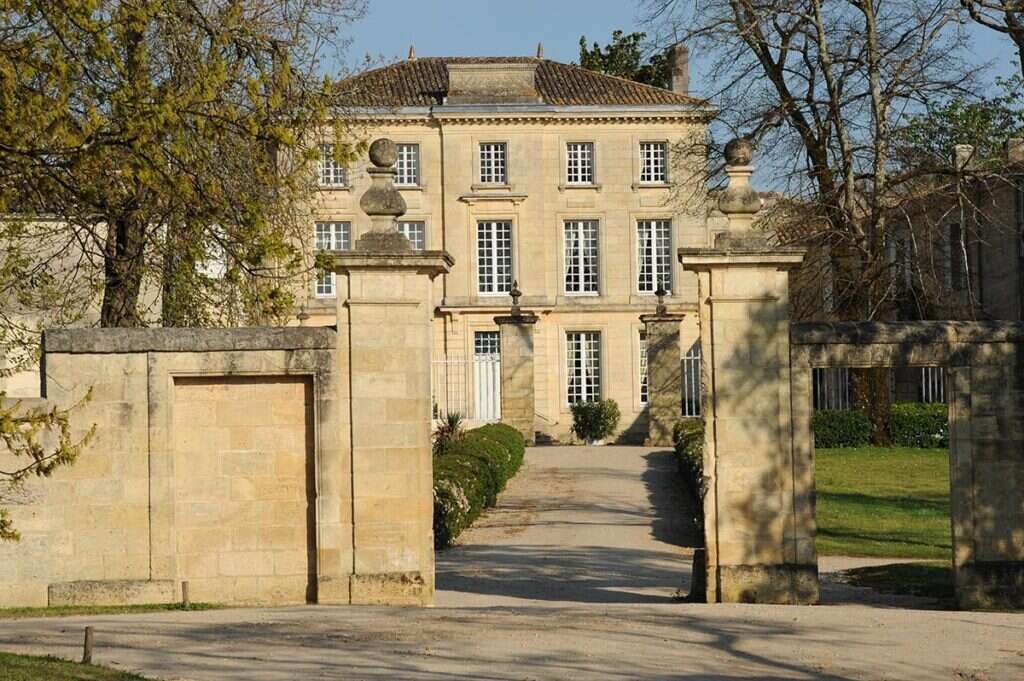
2023 Bordeaux Field notes: The endless appeal of Sauternes
Château Fleur Cardinale Grand Cru Classé (56% M, 37% CF, 7% CS)
SF | Black-cherry color, the aromas tilting toward the red cherry, with wild strawberries and plums in support. The palate is weightier than expected but with a pleasing, savory twist, which sits well with the volume of fruit. A little foursquare on the finish now, but plenty of time to soften, given that all the components are present and in earnest. | 92–93
Château de Fonbel Grand Cru (64% M, 28% CS, 8% Carm)
SF | Sand and gravel here, inter alia, in a vineyard that the Vauthiers describe as the jardin d’essai for Ausone itself, such is its mosaic of differing soils. A dense, striking ruby, with blackcurrant, violets, and chalky tannins, the acidity lifting the ensemble with benchmark energy and a very precisely etched finish. Notes of licorice and cayenne pepper, courtesy of the Carmenère. Silky, expressive tannins and a slowly unfurling tension, beautifully scented and pure. Clean and composed on the finish. A strident, extrovert personality, big-hearted and resourceful. | 93–94
Château Franc Mayne Grand Cru Classé (100% M)
SF | A rich, generous color, then a complex and intriguing nose, which marries pure red fruit, hints of smoke, then fig and plum—all this after a cloud of reduction has quickly dissipated. A forthright, elegant style, with plenty of limestone grip entwined with warm and generous fruit. Very accomplished and complete. | 93–94
Château Grand Mayne Grand Cru Classé (75% M, 25% CF)
SF | Saturated purple. A seductive, modern nose, vanillin and raspberry compote, hints of spice and forest floor. Unabashedly oaky, highly seductive—a style that is so appealing that some may feel duty bound to offer a critique. | 92–93
2023 Bordeaux Field notes: La Tour Figeac—La Chartreuse de St-Emilion
L’If Grand Cru (80% M, 20% CF)
SF | It is a delight to see the new cuverie, located amid the vines halfway between Trottevieille and Troplong Mondot. The focus is on purity of fruit, with fermentation in (new) cement vats of many different sizes, and élevage in 50% new wood. The wine is deeply pigmented and has a persuasive aromatic of blue and black fruit, the marriage of limestone and Cabernet Franc coaxing sappy black-tea flavors, hints of bitter chocolate, and a firm skeleton of acidity. Significantly more energy than the 2022 and built to last. An exciting new address. | 92–93
Château Larcis Ducasse 1er Grand Cru Classé (86% M, 14% CF)
SF | Tasting at Larcis this time (messrs Thienpont, Cyrille and Nicolas, usually meet me at Pavie Maquin), one can see how the shallow, loamy clay here has shaped the wine, underlining a difference in style. Larcis is broader, more open, with a compelling, generous aromatic of blueberries, sloes, and forest floor, and a broad expansive mid-palate with ripe, chalky tannins. Half of the élevage has taken place in larger barrels (500 liters) and even a 30hl foudre, because there is, it is felt, no need to feed the wine too much oxygen, such is its precocious generosity. | 93–94
Château Monbousquet Grand Cru (65% M, 20% CF, 15% CS)
SF | The lowest-lying of the Perse properties, and therefore prone to frost. No such problems in 2023. A distinct aromatic of roasted plum and vine smoke, thereafter exotic plants and black tea. The palate is rather too assertive, the acidity angular and intrusive, the fruit somewhat brooding and homogenized. The soils are sandier than elsewhere, the wine maybe therefore trying a little too hard to display gravitas. A folly of youth, one may surmise—sure to pass at some point. | 91–92
La Mondotte Grand Cru Classé (80% M, 20% CF)
SF | Gentle extraction, modest fermentation temperatures, and not too much new oak (40%); these are three answers given by Count Stephan von Neipperg when I compliment him on the integration of the Cabernet Franc and the Merlot. Nothing disjointed here, and it may leave an impression that the wine is almost too accessible (a long way from the dense garagiste style of old). Happily, this is not the case. Smoky, generous blue fruits to the fore; spice at the back. And just a hint of the herbaceous to offer tension. Impressive mid-palate concentration and a very fine, composed finish. A little less clay than its neighbor Troplong Mondot, the latter higher up, making for a slightly richer, rounder style. No complaints here, however. Quite the reverse. | 94–95
Château Moulin St-Georges Grand Cru (85% M, 15% CF)
SF | Hillside plots, west-facing, which are planted at high densities (up to 12,600 vines/ha). The wine has been vinified by plot and then treated to the luxury of 18 months in new wood. Deeply pigmented robe, then a nose of violets, red berries, and a touch of vanillin. The palate is rich, velvety, decadent, and yet refined in its composure. Black pepper, licorice, and late-season roses all claim their place. The wine is fantastically composed and supremely harmonious. | 93–94
Château Pavie 1er Grand Cru Classé A (51% M, 32% CF, 17% CS)
SF | An immense block, dominated by the limestone plateau, with additional clay and sand parcels on the slopes and a little farther down. The altitude of 330ft (100m) is the highest in St-Emilion—indeed in Bordeaux—and proved conducive in 2023 to marked diurnal variations that have fed into the texture of the wine. There are 28 autonomous plots, all vinified separately; the assembled wine is aged in 72% new oak. There is a finely chiseled aromatic tension here, more successful than with Les Arômes de Pavie. The same applies to the palate, where the two Cabernets work well together to add length, a spicy backdrop, and a firm foundation for the tannins. The acidity is less angular, a reflection of both the concentration of the fruit and of its inherent quality. The same applies to the tannins, their power evident but entirely fitting within a structural context. Nothing drying. Dark fruit, which is smoky, ripe, and dense of texture. Pavie continues to divide opinion but still sits at the top of the classification while others, for whatever reason, fall by the wayside. This success has not been achieved in a vacuum. | 95–96
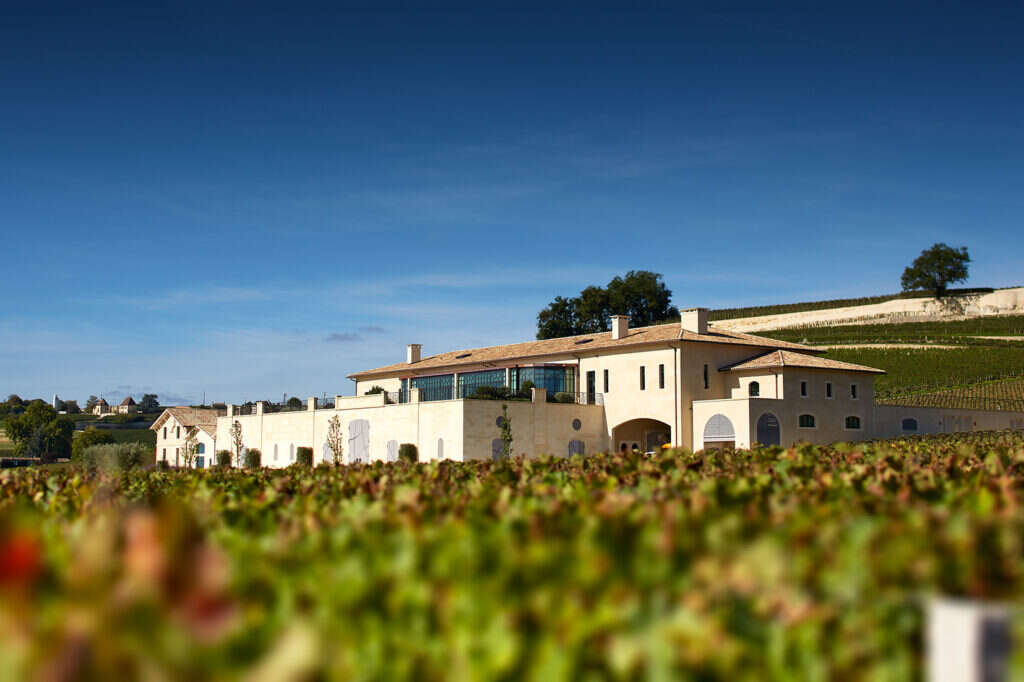
Les Arômes de Pavie Grand Cru (50% M, 50% CF)
SF | 53-year-old vines from the limestone plateau, aged in 50% new oak. The Cabernet Franc seems to be pushing hard from the back of the palate, its slightly vegetal character imposing on the Merlot, which does not relish the challenge. The disjoint is a function of youth but distracts from the ensemble. Mouth-coating tannins, no shortage of intensity, and a firm finish. | 91–92
Château Pavie Maquin 1er Grand Cru Classé (82% M, 17% CF, 1% CS)
SF | Next year will mark the 30th anniversary of the collaboration between the Thienpont and Derenoncourt families at Pavie Maquin; they have clearly made excellent progress, including promotion to the premier grand cru classé classification in 2006. An instructive tasting including the neighbor Larcis Ducasse underlines the difference in terroir, especially with the high proportion of limestone feeding the Cabernet Franc, which is influential on the back of the palate, offering a linear, controlled, very focused quality to the wine’s finish. Before all that, we are treated to an attractive black-fruit aromatic and an attack that is softly spicy behind the Merlot-dominated notes of blueberry and plum. Everything is nicely integrated already, and the 50% new wood seems to be entirely fitting. The average age of the vines is 50 years, though some of the 2013 Cabernet Franc vines now make a modest contribution. | 95–96
Château Peymouton Grand Cru (89% M, 10% CF, 1% CS)
SF | A rich seam of clay and a long, careful harvest have gifted a bright, deeply pigmented wine, with an aromatic of sloe, plum, and summer pudding. There is a lovely, lifted scent across the palate, discreet and poised, very 2023. Elegant and composed, the sine qua non of the Moueix style—and this one isn’t even a Pomerol! | 92–93
Château Poesia Grand Cru (70% M, 30% CF)
SF | A rich purple color, with a persuasive aromatic dominated by raspberries and blackcurrant leaf. Slightly stalky, too, with the Cabernet Franc particularly persuasive. Allusive, too. The palate has impressive concentration, grippy, assertive tannins that will soften in time, a certain vibrancy born of the high-quality old vines, and impressive authority on finish, which resolves the tension pleasingly. A good effort. | 92–93
Château Quinault l’Enclos Grand Cru (67% M, 16% CF, 17% CS)
SF | The juxtaposition of (primarily) gravel soils, (predominantly) larger vessels for the élevage (450-liter), and a healthy dose of the Cabernet twins forges a style with a gravelly aromatic and a broad and accessible texture, with quite dense cherry and baked-plum flavors, framed by elegant tannin and the pure acidity that one has come to expect from this fascinating vintage. | 93–94
Château Quintus Grand Cru (78% M, 22% CF)
SF | Three venerable St-Emilion estates, bought one after the other since 2011, currently make up Quintus, their dominion stretching from the limestone plateau to the gravel slopes. An impressive nose marries chalk and dark fruit, with hints of pepper and rose petal. The palate is dense, serious, and quietly potent (the 15% ABV is carried neatly), and with ripe and balancing tannins in support. | 93–94
Dragon de Quintus (72% M, 28% CF)
SF | New to en primeur, this considered worthy by the Dillon family, a Dragon with a long if not especially fiery tail. 2023 was the year of Merlot here, with the Cabernet Franc, itself north-facing, taking a backseat, leafy and assured but deferring to the raspberry plush of the Merlot and the cushion of 25% new oak. Nicely integrated already and with impressive length. | 91–92
Château La Serre Grand Cru (73% M, 27% CF)
SF | Deep purple robe, bright at the rim, then a nose of gravel, plum-skin, and briary. Discreet yet lingering; delicately scented, refined. Just a hint of woodsmoke and fennel. The attack is stern, slightly blunt, the Merlot uncharacteristically shy; a lovely, scented finish, however, with soft, chalky, almost dreamy tannins. A bright kiss of fruit on the finish. Finesse writ large. | 92–93
Château Simar Grand Cru (55% M, 30% CF, 15% CS)
SF | Ruby red, with purple reflections. Lively pepper, spice, energy—plenty of brio on the nose. Then juicy on the attack, somewhat ponderous in the middle, this but a brief hiatus before the redemption of a generous, harmonious, and savory finish. | 91–92
2023 Bordeaux Field notes: House of cards
Château Tertre Roteboeuf Grand Cru (80% M, 20% CF)
SF | The 2023 had, at the time of tasting (April 24), been in barrel (all new, of course) for just over two months so was but at the beginning of its journey. With a thin layer of clay and then a roche-mère of pure limestone, the wine is suitably opulent and profound, but also fresh and with balanced and focused acidity and significantly darker fruits than some ’23s, but it was ever thus chez Mitjavile, a style that it would be unwise to dismiss. When it is tasted directly from the barrel, one can hardly fail to be seduced by the wine’s dense, saturated color, its forthright but ripe tannins, its layers of velvety texture, and its crescendo of flavor at the back. If this is considered a little old-fashioned, then maybe one should incline to turning back the clock once in a while. | 95–96
Château La Tour Figeac Grand Cru Classé (70% M, 30% CF)
SF | Merlot, despite the mildew threat, performed very well this year. Pierre Blois concedes that it was not always easy to pursue a strict biodynamic approach, but he has succeeded admirably, aided, he maintains, by the high temperatures in June, despite the dangers of tropical humidity, which assisted in the overall structural development of the grapes. A very attractive nose of juniper and vine smoke, with hints of coal dust and myrtle. A wine with a neatly defined backbone, ripe but fine tannins, and a whisper of eucalypt on the finish, where the Cabernet Franc indulges a spicy peroration. In many ways, more complete than the 2022, the latter fuller of figure and marginally less convincing at the back of the palate. | 94–95
Château Troplong Mondot 1er Grand Cru Classé (84% M, 13% CS, 3% CF)
SF | Cool, south-facing clay vineyards around the famous water tower seal the Troplong Mondot magic. One is already happy with the explosive Merlot, a festival of opulent fruit, but it is the Cabernet Sauvignon, rare in St-Emilion, that underwrites structural success and distinctive identity. A juxtaposition, therefore, of density and freshness, courtesy, respectively clay and limestone, with 41 plots vinified separately and then assembled before Christmas. Only 60% new wood, the balance made up of one-year-old barrels and foudres. The work that Aymeric de Gironde started in 2017 continues apace, and the style, as always, is forward and juicy yet at the same time winningly complex. A couple of minutes in the glass, for example, is all that is required to unravel fascinating aromas of cedarwood and graphite, both perfectly complementary to the inherent fruit. The evolution on the palate is equally intriguing and is all held in place by tannins that have already achieved an impressive integration. | 95–96
Mondot Grand Cru (90% M, 10% CF/CS)
SF | A single plot close to, but not quite contiguous with, that of the senior wine, so vinified separately, without oak influence. Troplong Mondot’s youthful cousin is clearly a fast learner and already betrays signs of the same purity of fruit and generosity of mouthfeel, albeit without the same depth or complexity. Extremely approachable and already delicious, however. | 92–93
Château Trottevieille 1er Grand Cru Classé (53% CF, 44% M, 3% CF)
SF | A smoky nose, quite hard, with what cellar master Valério Montan describes, somewhat intriguingly, as réduction bourguignon. The fruit finds its voice soon enough, albeit from the darker end of the spectrum, coated with toasty oak tannins and a sensation recalling cocoa and bitter chocolate. A finely pixilated, detailed Trottevieille that will require a little effort and a little time—sound investments both. | 94–95
Château Valandraud 1er Grand Cru Classé (84% M, 8% CF, 8% CS)
SF | An extended harvest over the differing terroirs, clay lending depth, limestone a linear character, the pair happily entwined in a vintage that Jean-Luc Thunevin is happy to praise. To think, he jests, that they used to call this (cooler) part of St-Emilion “the St-Estèphe of the Right Bank.” Deep purple color, aromas of plum and violet, a hint of compote and vanillin, the oak still persuasive. There is grip, chalky acidity, lending a spinal cord and allowing the fruits and flowers to blossom without jeopardizing the structural integrity. There is nice poise on the finish, and a gentle lift. | 95–96
Blanc de Valandraud (53% SG, 47% SB)
SF | Delightfully atypical, Valandraud Blanc sings a hymn to the very particular flavor of Sauvignon Gris, which manages to be both exotic and fresh. Almond paste, mango, and pineapple, an oatmeal texture from seven months of bâtonnage, and a vanillin backdrop, courtesy of the 80% new barrels. One thinks of white Rhône, such is the texture, but such thoughts are soon banished when one considers the fine balancing acidity—all natural, needless to say—that is the signature of this wine. Only made in small quantities, this is very special. | 94–95
Virginie de Valandraud Grand Cru (90% M, 5% CF, 5% CS)
SF | Exceptionally bright, dense core and a lovely pink rim. Aromas of plum, forest floor, and spice. The black fruits come into their own on the palate, which is broad and expressive. The acidity is quite intense: There are hints of black tea and seaweed, then salinity at the back. A vertical structure, the exuberance of relatively young wines held in check by stolid foundations that need time to soften a little. | 92–93
Virginie de Valandraud Blanc (70% SB, 30% Sm)
SF | Jean-Luc describes the progress of his white wines on these cool (clay and limestone) soils as one of his greatest achievements and describes the hillside plots, rising in bucolic calm above the Fongaban Valley, as his El Dorado. The Virginie is aromatically pithy, with notes of lavender, chalk, and agrume all evidenced, then toasted almonds, white peach, and a pinch of sourdough. A soft spritz, still a little shy after nine months in new oak, and then an attractive, noble bitterness on the finish. | 94–95

